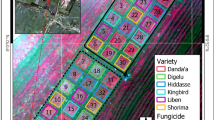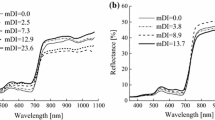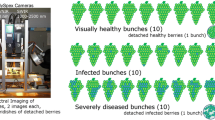Abstract
Efficient crop protection management requires timely detection of diseases. The rapid development of remote sensing technology provides a possibility of spatial continuous monitoring of crop diseases over a large area. In this study, to monitor powdery mildew in winter wheat in an area where a severe disease infection occurred, the capability of high resolution (6 m) multi-spectral satellite imagery, SPOT-6, in disease mapping was assessed and validated using field survey data. Based on a rigorous feature selection process, five disease sensitive spectral features: green band, red band, normalized difference vegetation index, triangular vegetation index, and atmospherically-resistant vegetation index were selected from a group of candidate spectral features/variables. A spectral correction was processed on the selected features to eliminate possible baseline effect across different regions. Then, the disease mapping method was developed based on a spectral angle mapping technique. By validating against a set of field survey data, an overall mapping accuracy of 78 % and kappa coefficient of 0.55 were achieved. Such a moderate but practically acceptable accuracy suggests that the high resolution multi-spectral satellite image data would be of great potential in crop disease monitoring.







Similar content being viewed by others
References
Broge, N. H., & Leblanc, E. (2001). Comparing prediction power and stability of broadband and hyperspectral vegetation indices for estimation of green leaf area index and canopy chlorophyll density. Remote Sensing of Environment, 76(2), 156–172.
Calderón, R., Navas-Cortés, J. A., Lucena, C., & Zarco-Tejada, P. J. (2013). High-resolution airborne hyperspectral and thermal imagery for early detection of Verticillium wilt of olive using fluorescence, temperature and narrow-band spectral indices. Remote Sensing of Environment, 139, 231–245.
Cao, X., Luo, Y., Zhou, Y., Duan, X., & Cheng, D. (2013). Detection of powdery mildew in two winter wheat cultivars using canopy hyperspectral reflectance. Crop Protection, 45, 124–131.
Congalton, R. G. (1991). A review of assessing the accuracy of classifications of remotely sensed data. Remote Sensing of Environment, 37, 35–46.
ENVI4.8. (2012). ITT Visual Information Solutions, Boulder, CO. www.ittvis.com.
Franke, J., & Menz, G. (2007). Multi-temporal wheat disease detection by multi-spectral remote sensing. Precision Agriculture, 8(3), 161–172.
Gitelson, A. A., Kaufman, Y. J., & Merzlyak, M. N. (1996). Use of green channel in remote sensing of global vegetation from EOS-MODIS. Remote Sensing of Environment, 58(3), 289–298.
Hicke, J. A., & Logan, J. (2009). Mapping whitebark pine mortality caused by a mountain pine beetle outbreak with high spatial resolution satellite imagery. International Journal of Remote Sensing, 30(17), 4427–4441.
Huang, W. J., Lamb, D. W., Niu, Z., Zhang, Y., Liu, L. Y., & Wang, J. H. (2007). Identification of yellow rust in wheat using in situ spectral reflectance measurements and airborne hyperspectral imaging. Precision Agriculture, 8(4), 187–197.
Huete, A. R. (1988). A soil-adjusted vegetation index (SAVI). Remote Sensing of Environment, 25(3), 295–309.
Huete, A. R., Didan, K., Miura, T., Rodriguez, E. P., Gao, X., & Ferreira, L. G. (2002). Overview of the radiometric and biophysical performance of the MODIS vegetation indices. Remote Sensing of Environment, 83(1), 195–213.
Kaufman, Y. J., & Tanre, D. (1992). Atmospherically resistant vegetation index (ARVI) for EOS-MODIS. IEEE Transactions on Geoscience and Remote Sensing, 30(2), 261–270.
Kruse, F. A., Lefkoff, A. B., Boardman, J. W., Heidebrecht, K. B., Shapiro, A. T., Barloon, J. P., et al. (1993). The spectral image processing system (SIPS): Interactive visualization and analysis of imaging spectrometer data. Remote Sensing of Environment, 44(2–3), 145–163.
Lee, W. S., Alchanatis, V., Yang, C., Hirafuji, M., Moshou, D., & Li, C. (2010). Sensing technologies for precision specialty crop production. Computers and Electronics in Agriculture, 74(1), 2–33.
Liang, S. L., Fang, H. L., & Chen, M. Z. (2001). Atmospheric correction of Landsat ETM+ land surface imagery-Part1: Methods. IEEE Transactions on Geoscience and Remote Sensing, 39(11), 2490–2498.
Mahlein, A., Oerke, E., Steiner, U., & Dehne, H. W. (2012). Recent advances in sensing plant diseases for precision crop protection. European Journal of Plant Pathology, 133(1), 197–209.
Moshou, D., Bravo, C., Oberti, R., West, J. S., Ramon, H., Vougioukas, S., et al. (2011). Intelligent multi-sensor system for the detection and treatment of fungal diseases in arable crops. Biosystems Engineering, 108(4), 311–321.
Naidu, R. A., Perry, E. M., Pierce, F. J., & Mekuria, T. (2009). The potential of spectral reflectance technique for the detection of Grapevine leafroll-associated virus-3 in two red-berried wine grape cultivars. Computers and Electronics in Agriculture, 66(1), 38–45.
Oumar, Z., & Mutanga, O. (2012). Using WorldView-2 bands and indices to predict bronze bug (Thaumastocoris peregrinus) damage in plantation forests. International Journal of Remote Sensing, 34(6), 2236–2249.
Roujean, J. L., & Breon, E. M. (1995). Estmating PAR absorbed by vegetation from bidirectional reflectance measurements. Remote Sensing of Environment, 51(3), 375–384.
Rouse, J.W., Haas, R.H., Schell, J.A., & Deering, D.W. (1973). Monitoring vegetation systems in the Great Plains with ERTS. Third ERTS Symposium, NASA SP-351, NASA, Washington, DC, (Vol. 1, pp. 309–317).
Sankaran, S., Mishra, A., Ehsani, R., & Davis, C. (2010). A review of advanced techniques for detecting plant diseases. Computers and Electronics in Agriculture, 72, 1–13.
Wang, X., Zhang, M., Zhu, J., & Geng, S. (2008). Spectral prediction of Phytophthora infestans infection on tomatoes using artificial neural network (ANN). International Journal of Remote Sensing, 29(6), 1693–1706.
Weng, Q. H. (2011). Advances in environmental remote sensing, Chapter 5. In R. L. Pu & P. Gong (Eds.), Hyperspectral remote sensing of vegetation bioparameters. Boca Raton: CRC Press.
West, J. S., Bravo, C., Oberti, R., Lemaire, D., Moshou, D., & McCartney, H. A. (2003). The potential of optical canopy measurement for targeted control of field crop diseases. Annual review of Phytopathology, 41, 593–614.
Yang, C. M., Cheng, C. H., & Chen, R. K. (2007). Changes in spectral characteristics of rice canopy infested with brown planthopper and leaffolder. Crop Science, 47(1), 329–335.
Yang, C., Everitt, J. H., & Fernandez, C. J. (2010). Comparison of airborne multi-spectral and hyperspectral imagery for mapping cotton root rot. Biosystems Engineering, 107, 131–139.
Yuan, L., Zhang, J. C., Shi, Y. Y., Nie, C. W., Wei, L. G., & Wang, J. H. (2014). Damage mapping of powdery mildew in winter wheat with high resolution satellite image. Remote sensing, 6(5), 3611–3623.
Zhang, J. C., Pu, R. L., Wang, J. H., Huang, W. J., Yuan, L., & Luo, J. H. (2012). Detecting powdery mildew of winter wheat using leaf level hyperspectral measurements. Computers and Electronics in Agriculture, 85, 13–23.
Zhang, J. C., Pu, R. L., Yuan, L., Wang, J. H., Huang, W. J., & Yang, G. J. (2014). Monitoring powdery mildew of winter wheat by using moderate resolution multi-temporal satellite imagery. PLoS One, 9(4), e93107.
Zhang, M., Qin, Z., Liu, X., & Ustin, S. L. (2003). Detection of stress in tomatoes induced by late blight disease in California, USA, using hyperspectral remote sensing. International Journal of Applied Earth Observation and Geoinformation, 4, 295–310.
Zhao, C. J., Huang, M. Y., Huang, W. J., Liu, L. Y., & Wang, J. H. (2004). Analysis of winter wheat stripe rust characteristic spectrum and establishing of inversion models. In: R. King & M. Datcu (Eds.), In Proceedings of Geoscience and Remote Sensing Symposium (Vol. 6, pp. 4318–4320). Alaska.
Acknowledgments
This work was subsidized by National Natural Science Foundation of China (41301476), Beijing Nova Programme, China (Z151100000315059), and UK Newton project entitled “A system to improve the rational use of pesticides against locusts”. The authors are grateful to Mr. Weiguo Li, Ms. Hong Chang for their helps in field data collection.
Author information
Authors and Affiliations
Corresponding author
Rights and permissions
About this article
Cite this article
Yuan, L., Pu, R., Zhang, J. et al. Using high spatial resolution satellite imagery for mapping powdery mildew at a regional scale. Precision Agric 17, 332–348 (2016). https://doi.org/10.1007/s11119-015-9421-x
Published:
Issue Date:
DOI: https://doi.org/10.1007/s11119-015-9421-x




